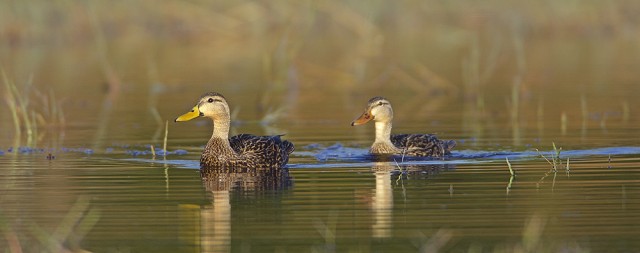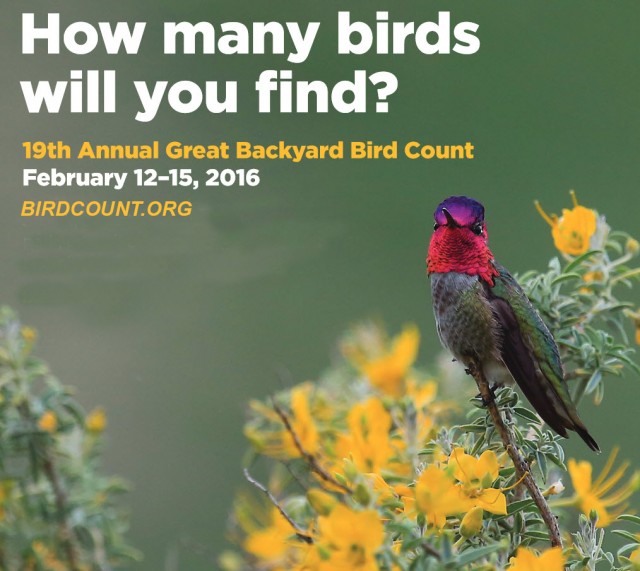
Dave Allen, of Corpus Christi, submitted this wonderful image of a pair of Mottled Ducks in their natural habitat to the four-day GBBC photo contest last year. Over 200,000 images were entered and Dave’s photo was judged to be among the top 10 in the ‘Birds in their Habitat’ category. David Allen photo.
05 Feb 2016 – Count Birds, Take Photographs
It is that time of year again. It is time for the Great Backyard Bird Count! The Great Backyard Bird Count (GBBC) is an annual event held every February. This year the count days are during Valentine’s Day weekend: Friday, February 12th through Monday, February 15th.
All you have to do is count the number of individual birds of each species you see during a 15-minute period (or longer) on one or more of the four days of the GBBC. This can be in your backyard, at a feeder, at a park or natural area, or almost any area where there are birds. You may then enter your numbers into the www.birdcount.org database.
This is a global count so your results will be compiled into a worldwide “snapshot” of how the birds are doing in 2016. Birders and scientists around the world will be able to see just how many species, and how many birds of those species, are where.

Every year, the Great Backyard Bird Count makes it easy to participate, no matter your skill level. They spread the word with stunning bird photographs such as this Anna’s Hummingbird on the 2016 GBBC poster. Although normally found on the West Coast, these hummers do occasionally show up in Bee County. In the winter of 1967, an Anna’s was seen in Beeville by Mrs. Teal Atkins, Velma Geiselbrecht, and Mrs. J. J. Jordan for over a month!
The GBBC has been going on since 1998 making the 2016 count the 19th in a row. This means we now will have 19 “snapshots” of the bird situation on Planet Earth. These data can be used to spot trends in population numbers, and in migration shifts. We will have a much better idea of the health of the bird species in our world.
Last year, 2015, was a good year for the GBBC. Birders from over 100 countries participated. A record number of 5,090 species were documented (that is nearly half of the world’s species!), and more than 147,000 individual checklists were submitted.
Can you guess what species was the most likely to be listed on a checklist? If you said, Northern Cardinal, you are right! Cardinals appeared on 59,083 checklists last year. Since the Northern Cardinal is a North American species, this reflects that participation in the Great Backyard Bird Count is still predominantly in the US and Canada. In fact all ten of the top ten species reported on checklists were North American birds.
But there was one surprise: For the first time a Eurasian species was on the most numerous birds list. It was the Brambling. It was the third most populous bird in the world. Over 3 million individual Bramblings were reported from one German site alone. There were even a few rare sightings of Bramblings in North America last year. It seems Bramblings are numerous …and they get around!
On the state/province level, Texas dropped to fifth place (down from third) in the number of checklists submitted. Ahead of us were California, Pennsylvania, New York, and Florida. Even though there were fewer checklists from Texas last year, they must have been good ones. We reported a total of 366 species. That was only 10 species shy of the top slot taken by California (with 376 species.)
Counting birds, species, checklists, and number of participants is fun. It is always nice to have a bit of friendly competition. But the real winners in the Great Backyard Bird Count are the birds themselves. By knowing where the birds are, and how their numbers are changing from year to year, we can monitor the health of their populations. And from that we can get a picture of our planet’s overall health.
To make things even more fun, there is a GBBC Photo Contest. Just photograph birds during the four day period and submit your best shots in six categories: Bird in its Habitat, Composition, Bird Behavior, Groups of Birds, People and Birds, and Overall. And be sure to take a look at the Photo Gallery at www.birdcount.org for previous winners.
Last year David Allen, our friend from Corpus Christi, submitted one of his photos of Mottled Ducks gliding through a marsh. Over 200,000 images were submitted and Dave’s was judged to be among the top 10 within the ‘Birds in their Habitat’ category.
You too might capture a winning photograph. Dust off your camera and get out there. Even if you personally do not want to count birds, you can take photos of people who are and perhaps garner one of the coveted spots in the People and Birds category.
If you participated last year, I hope you’ll join us once again. If you are new to the GBBC, you will find it easy, fun, and free. Just go to the website and sign up. People of all ages and abilities are welcome. Count the birds in your backyard at least once during the February 12-15 and have fun!
If you would like to offer comments, please click through to the discussion page
